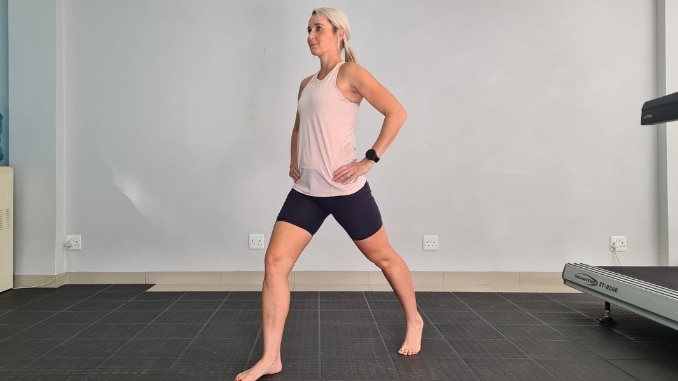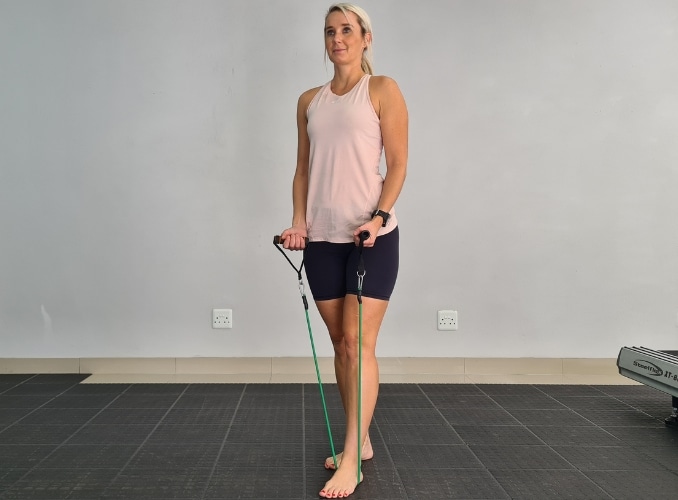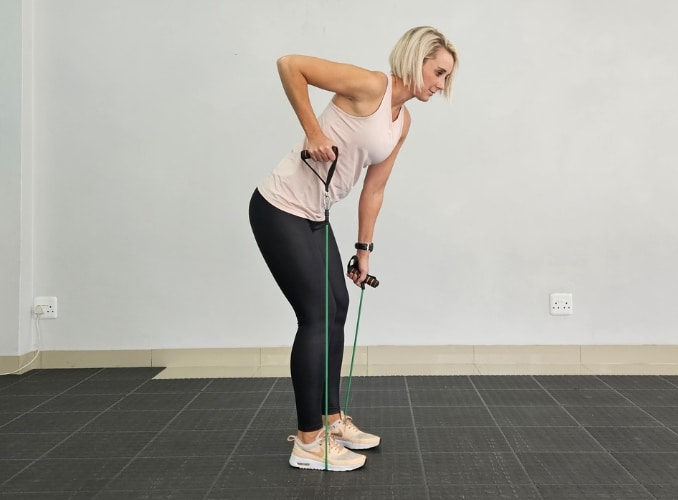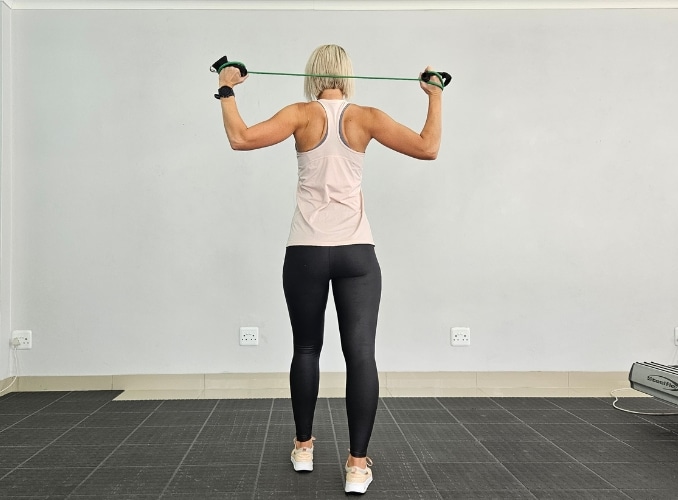Are you looking to strengthen and tone your shoulders? Look no further than shoulder band exercises! These exercises are a great addition to any fitness routine and can help you improve shoulder stability, enhance posture, and also prevent injuries. Whether you're an athlete, a strength training enthusiast, or someone who wants to have well-defined shoulders, incorporating shoulder band exercises into your workout routine can be highly beneficial.
Resistance band shoulder exercises utilize resistance bands to target the muscles in your shoulders, including the deltoids, rotator cuffs, and upper back. The bands provide constant tension throughout the movement, challenging your muscles differently than traditional weights.
Furthermore, choose a resistance band that suits your fitness level to get started with a shoulder workout. Begin with light resistance and then gradually increase as you get stronger. Examples of shoulder band exercises include lateral raises, front raises, external rotations, and shoulder presses.
So why wait? Get ready to strengthen and tone your shoulders with these effective shoulder band exercises. Your shoulders will thank you!
What are Resistance Bands?

Resistance bands are versatile fitness tools that provide resistance during exercises, helping to strengthen and tone muscles. They are made of elastic materials and come in various sizes and levels of resistance. Resistance bands are particularly effective for shoulder exercises because they target the muscles in your shoulders from different angles and provide constant tension throughout the movement.
Resistance bands provide variable resistance that challenges muscles in a full range of motion. This helps to activate more muscle fibers, leading to more remarkable muscle development and strength gains. Additionally, resistance bands are lightweight, portable, and affordable, making them a convenient option for home workouts or when traveling. You can perform various shoulder exercises with resistance bands to improve your shoulder strength and stability.
Benefits of Incorporating Shoulder Band Exercises
Incorporating shoulder band exercises into your fitness routine offers numerous benefits for your shoulder muscles, posture, and overall fitness. Here are some of the key advantages of adding shoulder band exercises to your workouts:
- Improved shoulder stability: Shoulder band exercises target the muscles that stabilize the shoulder joint, such as the rotator cuffs. Strengthening these muscles can improve shoulder stability, reducing injury risk and also enhancing upper body exercise performance.
- Increased muscle strength and tone: Resistance bands activate more muscle fibers throughout the entire range of motion in your shoulders. This increases muscle strength and tone, helping you develop well-defined and sculpted shoulders.
- Enhanced posture: Weak shoulder muscles can contribute to poor posture and rounded shoulders. Therefore, shoulder band exercises can help correct these imbalances by strengthening the muscles responsible for pulling your shoulders back and down, promoting a more upright posture.
- Versatility: Resistance bands offer a wide range of exercises that target different parts of your shoulders. There are various resistance band exercises, whether you want to focus on your deltoids, rotator cuffs, or upper back muscles. This versatility allows you to tailor your workouts to specific goals and needs.
- Injury prevention: Strengthening the muscles around your shoulder joint can also lower the possibility of experiencing common shoulder injuries, including rotator cuff tears and impingements. Properly conditioned shoulder muscles provide stability and support, minimizing the likelihood of strains or overuse injuries.
In short, incorporating shoulder band exercises into your fitness routine can provide these benefits. Whether you're an athlete looking to improve your performance or want strong and well-defined shoulders, shoulder band exercises are a valuable addition to any workout regimen.
Types of Resistance Bands for Shoulder Exercises
Regarding shoulder resistance band training and exercises, you have many options when selecting from the different types of resistance bands available. Each type offers different resistance levels, allowing you to progress in your strength training journey. Here are the common types of resistance bands used for shoulder exercises:
- Loop bands: Loop bands, also known as mini bands or resistance loops, are small, circular bands that can be placed around your wrists, forearms, or ankles. They come in different resistance levels, from light to heavy. Loop bands are excellent for shoulder exercises like lateral raises and external rotations, as they provide resistance in all directions.
- Tube bands with handles: Tube bands consist of a rubber or latex tube with handles attached to both ends. They usually come with interchangeable resistance levels, allowing you to adjust the intensity of your shoulder exercises. Tube bands with handles are great for exercises like shoulder presses and front raises, as the handles provide a comfortable grip and stability during the movements.
- Figure-eight bands: Figure-eight bands are shaped like the number 8 and have handles on each end. They offer various resistance levels and are suitable for multiple shoulder exercises. The figure-eight design allows for easy gripping and provides resistance in various directions, making it ideal for rotational exercises, such as external and internal rotation.
When choosing resistance bands for shoulder exercises, consider your current fitness level and the specific activities you plan to perform. Beginners may start with lighter resistance bands and gradually progress to heavier ones as their strength improves. It's also essential to ensure that your resistance bands are made of high-quality materials to ensure durability and safety during workouts.
Now that you know the different types of resistance bands available for shoulder exercises, let's explore how these band exercises can help address common shoulder issues.
Choosing the Right Resistance Band
Choosing the right resistance band is vital for getting the most out of your shoulder exercises. Here are a few factors to consider when selecting a resistance band for shoulder exercises:
- Resistance level: Resistance bands are available in different levels, ranging from light to heavy. For beginners, it's advisable to begin with a less resistance band to emphasize the importance of mastering correct form and technique. As you get stronger, you can progress to heavier resistance bands to continue challenging your muscles.
- Band Material: Resistance bands are also commonly made of latex, rubber, or fabric. Latex and rubber bands offer more resistance and elasticity, making them suitable for advanced users. Fabric bands, on the other hand, are often less stretchy and provide lower resistance, making them ideal for beginners or those with joint sensitivities.
- Band length: The length of the resistance band determines the range of motion and the exercises you can perform. Longer bands allow for a more excellent range of motion, while shorter bands are more suitable for exercises with limited space, such as lateral raises. Consider the exercises you plan to do and choose a band length that accommodates your needs.
- Durability: Ensure your resistance band is made from durable materials for long-term use. Look for bands with reinforced seams and solid handles or attachments to prevent snapping or breaking during exercises.
It's also worth noting that some resistance bands come in sets with different resistance levels. These sets are convenient if you want options for other exercises or plan to progress in your strength training journey. Experiment with varying resistance bands to find the one that challenges your muscles without compromising your form.
Now that you have chosen the right resistance band, let's dive into how to perform shoulder exercises with resistance bands.
Best Shoulder Band Exercises at Home for Strengthening and Toning
Warm-Up:
1. Shoulder Rolls
Begin in an upright standing position with your feet shoulder-width apart, maintaining good alignment with your head, shoulders, hips, and legs. Engage your core. Lift your shoulders, then roll them down and back until you feel resistance in your shoulder blades. Lower your shoulders to the starting position, relax, and repeat the movement in the opposite direction. Complete 10 repetitions.
 |
 |
 |
Shoulder Rolls
2. Shoulder Twist
Begin in an upright standing position with your feet shoulder-width apart, maintaining good alignment with your head, shoulders, hips, and legs. Place your hands on your shoulders. Engage your core and twist your upper body to one side, keeping your hips forward. Return to the starting position and repeat the movement on the opposite side. Complete 10 repetitions.
 |
 |
 |
Shoulder Twist
3. Side Lunge
Begin in an upright standing position with your feet wider than shoulder-width apart, maintaining good alignment with your head, shoulders, and hips. Place your hands on your hips. Engage your core and shift your body weight to one side while extending your opposite leg. Return to the starting position and repeat the movement on the opposite side. Complete 10 repetitions.
 |
 |
Side Lunge
4. Standing Hip Thrust
Begin in an upright standing position with your feet hip-width apart, maintaining good alignment with your head, shoulders, hips, and legs. Place your hands on your hips. Take a step back with one foot and bend your front knee directly over your ankle. Straighten your back leg as you stack your back heel over your toes. Engage your core. Bend your back knee as you squeeze and tilt your pelvis back, similar to flattening your lower back. Return to the starting position and repeat the movement. Complete 10 repetitions.
 |
 |
Standing Hip Thrust
Routines:
1. Shoulder Sweep
Firstly, begin in an upright standing position with your feet shoulder-width apart, maintaining good alignment with your head, shoulder, and hips. Secondly, step on the center of the resistant tubing with one foot and hold the handles in each hand with your palms facing upward. Thirdly, engage your core and sweep your arms to bring the tubing handles to shoulder height. Lastly, return to the starting position and repeat the movement. After several repetitions, switch to the opposite leg. Complete 10 repetitions on each side.
 |
 |
Shoulder Sweep
This workout targets the bicep muscles located on the front of your upper arm. It aids in enhancing and firming these muscles, leading to enhanced arm strength and a more appealing appearance.
Remember to use the band straight proper form, start with a manageable resistance, and adjust the band tension according to your fitness level. If you're unfamiliar with the exercise or resistance bands, consider seeking guidance from a fitness professional.
2. Single Arm Lateral Raise
Begin in an upright standing position with your feet shoulder-width apart, maintaining a good alignment with your head, shoulder, hip, and legs. Step on the center of the resistant tubing with one foot and hold one end of the tubing handle in one hand. Keeping your arm straight and your core engaged, extend your arm out to the side to shoulder height. Lower your arm to return to the starting position and repeat the movement. After several repetitions, repeat the movement on the opposite side. Complete 10 repetitions.
 |
 |
Single Arm Lateral Raise
Lateral raises primarily work the lateral deltoid muscles in your shoulders. This exercise helps to build broader and more defined shoulder blades, contributing to an overall balanced upper body appearance.
To do shoulder strengthening and make the exercise easier, create more slack on the side with the dropped handle. For shoulder exercises with added challenges, reduce the space.
3. Bend Over Rows
For this exercise, use a medium-resistant tubing.
Begin in an upright standing position with your feet shoulder-width apart. Step one foot forward on the center of the resistant tubing, holding the tubing handles in each hand. Hinge through your hips to lean your upper body forward, maintaining a good alignment with your head, shoulders, hips, and back leg. Contract your core and pull your arms back in a rowing motion, keeping your elbows 30 to 45 degrees away from your body. Lower your arms to return to the starting position and repeat the movement. After several repetitions, switch to the opposite leg. Repeat the movement for 10 repetitions on each side.
 |
 |
Bend Over Rows
4. Bicep Curls
Begin in an upright standing position with your feet shoulder-width apart, maintaining good alignment with your head, shoulder, hips, and legs. Step one foot forward on the center of the resistant tubing. Hold the tubing handles in each hand with your palms facing upward, pressing your elbows against the side of your body. Engage your core and curl both arms to bring the tubing handles to chest height. Return to the starting position and repeat the movement for 10 repetitions.
Furthermore, to intensify the movement, you can alternately curl your arms to bring the tubing handle to chest height.
 |
 |
Bicep Curls
5. Side Steps
Begin in an upright standing position on the center of the resistance tubing with your feet wider than shoulder-width apart, maintaining good alignment with your head, shoulder, and hips. Cross the resistance tubing and hold each opposite handle in each hand at hip height, creating an X shape in front of your body. Engage your core and then step from side to side. Repeat the movement for 10 repetitions.
 |
 |
Side Steps
This exercise involves stepping on the resistance band and crossing it over in front of the body while performing various upper-body movements. It enhances coordination, engages multiple muscle groups, and also improves cardiovascular fitness.
6. Triceps Kickback
Firstly, begin in an upright standing position on the center of the resistance tubing with your feet hip-width apart, holding a handle in each hand with your palms facing your body. Secondly, slightly bend your knees and hinge through your hips. Thirdly, bend your arms, keeping your elbows 30 to 45 degrees away from your body. Lastly, engage your core and extend your one arm back to slightly past your hips. Return to the starting position and then repeat the movement. After several repetitions, repeat the movement on the opposite side. Complete 10 repetitions.
 |
 |
Triceps Kickback
Triceps kickbacks target the triceps muscles on the back of your upper arms. It helps tone and strengthen these muscles, essential for arm stability and pushing movements.
7. Shoulder External Rotation
For this exercise, use light-resistant tubing.
Begin in an upright standing position with your feet shoulder-width apart, maintaining good alignment with your head, shoulders, hips, and legs. Hold a tubing handle in one hand. Bend your arm, keeping your upper arm aligned with your body. Anchor the tubing with your other hand to create resistance. Engage your core and rotate your arm out to the side. Rotate your arm back to the starting position and repeat the movement. After several repetitions, repeat the movement on the opposite side. Complete 10 repetitions.
 |
 |
Shoulder External Rotation
Resistance band exercises can strengthen the rotator cuff muscles, which sustain stability in the shoulder joint. This can help prevent injuries and improve shoulder mobility.
8. Shoulder Press
For this exercise, use a lighter resistance band.
Begin in an upright standing position with your feet shoulder-width apart, maintaining good alignment with your head, shoulders, hips, and legs. Hold the resistance band overhead with both hands, pulling apart slightly for resistance. Contract your core and bend your arms to lower your elbows to shoulder height, pulling the band apart. Raise your arms to return to the starting position and repeat the movement for 10 repetitions.
 |
 |
Shoulder Press
This exercise focuses on the upper back muscles, including the rear deltoids and upper traps. It helps improve posture, shoulder stability, and also upper body strength.
Alternative variation: If holding the arm above the head is too much, you can try in front of your chest and then pull back.
Tips for Proper Form and Technique
Maintaining correct form and employing the proper technique is essential when executing shoulder band exercises to ensure effectiveness and reduce the risk of injury. Here are some tips to keep in mind:
- Start with light resistance: If you're new to resistance bands or shoulder band exercises, begin with a lighter resistance band. This will enable you to concentrate on the proper form and technique without putting too much strain on your muscles.
- Maintain proper alignment: Keep your arm straight, shoulders down and relaxed, and also your core engaged throughout the exercises. Avoid shrugging your shoulders or arching your back.
- Control the movement: Slow and controlled moves are vital for maximizing the benefits of shoulder band exercises. Avoid using momentum or swinging your arms.
- Focus on the muscle contraction: Squeeze and then engage the targeted shoulder muscles at the top of each movement. This will help you get the most out of each exercise.
- Breathe properly: Inhale during the lowering phase and exhale during the lifting phase to stabilize your core and improve performance.
Conclusion
Shoulder band exercises are a fantastic way to strengthen and tone your shoulders while improving shoulder stability and preventing injuries. Adding resistance bands to your exercise regimen can efficiently target your shoulder and upper back muscles. Whether new to fitness or an experienced enthusiast, you can tailor these exercises to match your fitness level and objectives. To ensure safety:
- Start with low resistance and gradually increase as your strength improves.
- Always prioritize proper form and technique and listen to your body.
- If you experience any shoulder pain or discomfort, discontinue the exercise and seek guidance from a healthcare professional.
So why wait? Get ready to strengthen and tone your shoulders with these effective shoulder band exercises. Your shoulders will thank you!
Now that you have the knowledge and tools to start, it's time to take action. Incorporate shoulder band exercises into your fitness routine and start reaping the benefits. Strengthen and tone your shoulders, improve shoulder stability, enhance posture, and prevent injuries. Your shoulders will not only look great but also feel strong and functional. Start today and enjoy the results!





